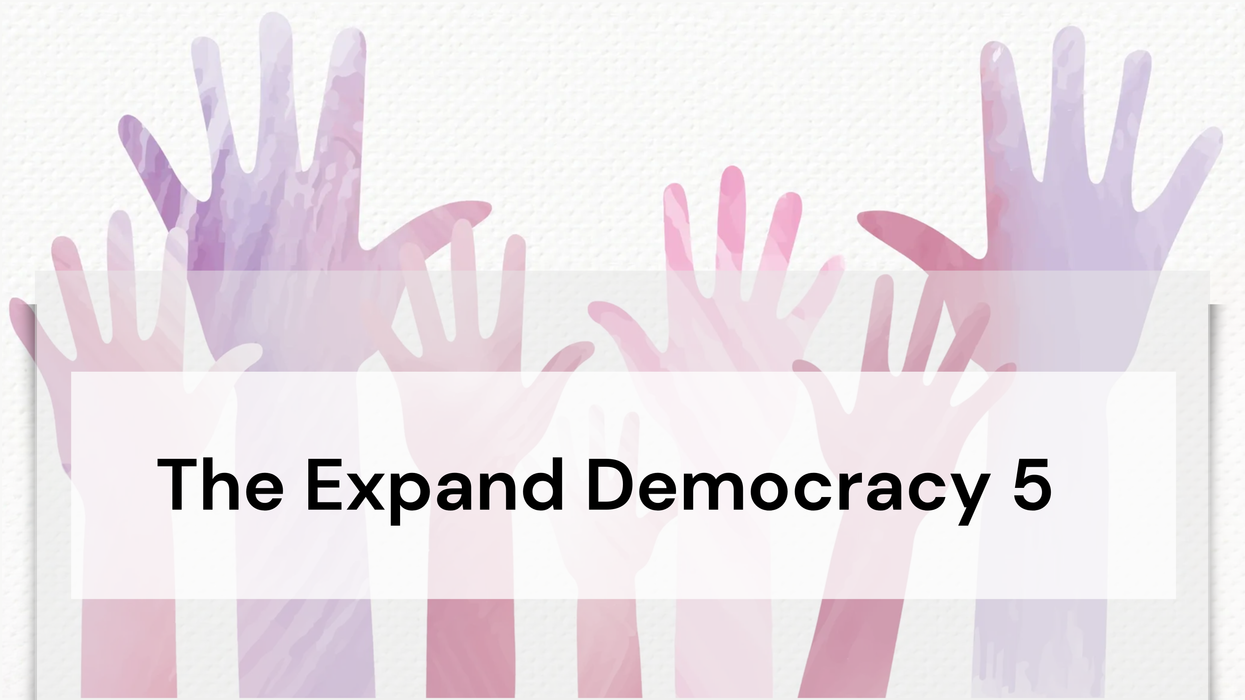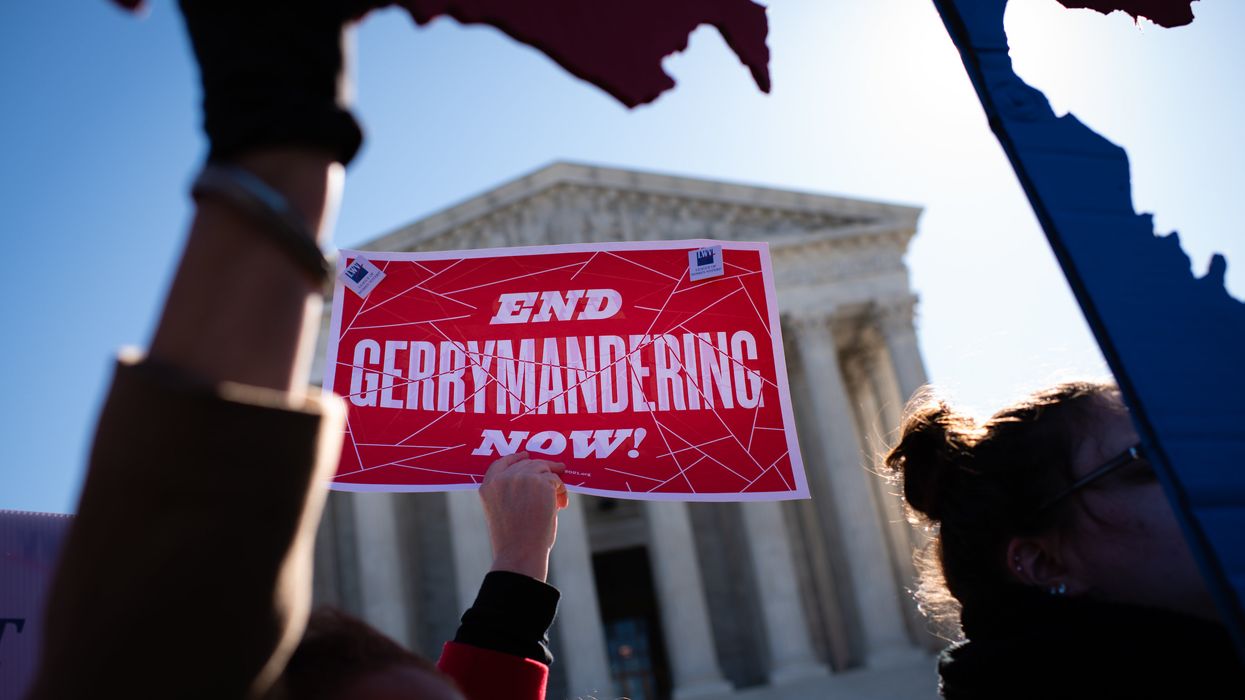Welcome to the latest edition of The Expand Democracy 5. In August, the Expand Democracy team will be taking a break from creating new content, but we look forward to sharing grouped content from this year’s editions that they believe still remains relevant. Today's stories include:
🗳️ Deep dive: Ranked choice voting and its critics
💰 Why it’s a problem that Texas “re-gerrymandering” is such an issue
💪 Expanding the citizen initiative
🎬 Deliberative democracy in action
🕙 Timely links
In keeping with The Fulcrum’s mission to share ideas that help to repair our democracy and make it live and work in our everyday lives, we intend to publish The Expand Democracy 5 in The Fulcrum each Friday.
If you want to suggest a pro-democracy idea for coverage in The Expand Democracy 5, please use the contact form at Expand Democracy.
 Deep Dive: Ranked Choice Voting and Its Critics - Lessons from New York City
Deep Dive: Ranked Choice Voting and Its Critics - Lessons from New York City
“How Brad Lander Helped Push Zohran Mamdani Toward Victory” - New York Times
We must invest in a spectrum of reform ideas in order to achieve better elections and a healthier democracy, which is why we at Expand Democracy seek to catalyze attention to a mix of pro-democracy ideas and projects. Ranked choice voting (RCV) is one such idea I’ve now championed for 33 years, mostly while leading FairVote. It makes more sense to me than ever.
The history of the modern advocacy effort for RCV is instructive. There is truth to the maxim (wrongly attributed to Gandhi) that “First they ignore you, then they laugh at you, then they fight you, then you win.” The last phase, though, is far from linear. Pushback can come in many forms, and until you cement change, your progress is vulnerable. While RCV is secure now in nations like Australia and Ireland, its American advocates have work to do.
RCV faces organized opposition that brazenly distorts and twists facts. Self-interested incumbents and related interest groups can fear that it will make elections harder. It also encounters tactical opponents, who play up minor faults in the service of some other agenda, such as pushing a rival voting system. It faces more genuine skepticism from election officials who worry that RCV is being pushed too quickly without enough consideration of the burdens it might place on them. Academics often add fuel to the fire, as it’s easier to publish an article finding fault than affirming value, as exhaustively detailed by Steven Hill.
The ground for this opposition is a simple reality – nothing is perfect. RCV of course cannot guarantee that elections will have a definitive "majority candidate” Not every voter will rank every candidate, and some three (0.3%) out of every 1,000 voters on average will make an error that invalidates their ballot. Candidates, of course, will win who some people dislike, or who make mistakes after they take office. The critics can always point fingers, and advocates have to keep showing that the positive values outweigh the negative.
Fortunately, RCV is overall working well. Still, that doesn’t stop the critics, as shown by recent responses to the RCV primary in New York City. Critics are engaging in “swift boating” - that is, the system worked so well that opponents have to do everything they can to suggest it didn’t. Those fundamentals in New York included:
- The primary nearly drew the most votes in New York City's primary history, with winner Zohran Mamdani gaining more votes than any previous mayoral nominee, and with historic youth turnout that far outpaced any other primary in the nation this year.
- In a crowded field where 20% of voters backed someone other than Mamdani or Andrew Cuomo, 95% of the votes counted for Mamdani or Cuomo in the final instant runoff.
- As Common Cause New York reported on its exit survey, “Ranked choice voting was incredibly popular: 77% said that they want ranked choice voting in future local elections.”
- As FairVote reported, Mamdani not only handily defeated Cuomo, but would have defeated every other candidate by a margin of greater than two to one - and more than 90% of backers of non-Cuomo candidates ranked more than one candidate.
- As RepresentWomen reported, the city council sustained its 31-member super-majority of women members, up from just 13 in 2021, and it is historically diverse in other metrics.
But that didn't stop sniping from Sam Oliker-Friedland, executive director of the Institute for Responsive Government, in a commentary in The Hill. (Mandani won, but ranked choice voting lost.) Oliker-Friedland contends: "The mayoral race didn’t elevate a broadly supported candidate," despite all the evidence to the contrary. He writes that "There is little evidence to suggest that large numbers of voters were thoughtfully ranking across ideological lines," despite the FairVote data showing that three candidates would have defeated Cuomo head-to-head, including council speaker Adrienne Adams, who trailed Cuomo in first choices by 36% to 4%. He brings up the trope that RCV is disadvantaging people of color despite overwhelming evidence to the contrary as collected by FairVote, and the fact that the Department of Justice uphold RCV in a key Voting Rights Act decision involving New York, He ignored that in the case of the mayoral primary, the number of ballots counting in the final decision due to RCV were some 50 times greater than the number of overvotes.
Or take law professor Ned Foley, who repeatedly critiques RCV (including in massively wrong conjectures about Mamdani in this primary), because it’s possible that a last-place candidate in an RCV race might be the second choice of enough voters that they would theoretically defeat every other candidate – an outcome that Harvard law professor Nicholas Stephanopoulos showed happens less than one percent of RCV races and that, as Michael Parsons and Rachel Hutchinson thoughtfully argue is not worth upending RCV elections to achieve.
Rather than get bogged down in grievances about RCV’s critics, the reformer’s job is to keep making the case and supporting it in practice. I salute groups like FairVote and Rank the Vote, as well as an impressive coalition of state and national groups, for doing what’s necessary. With their dedication, yes, RCV will win.
The latest good news from RCV advocates comes from Washington, D.C., where Make All Votes Count DC has have done a terrific job keeping RCV on track for first use in its June 2026 primaries and November 2026 general elections As reported by the Washington Post on July 30: “D.C. voters overwhelmingly passed a ballot initiative last year that would open up primary elections to independent voters and institute ranked-choice voting, allowing voters to rank candidates in order of preference… council members Christina Henderson (I-At Large) and Brianne K. Nadeau (D-Ward 1) successfully championed an effort to include $421,000 for ranked-choice voting in the 2026 budget, followed by an additional $39,000 each of the following three years, mostly for notifying and educating voters about the change.”
 Why it’s a Problem that “Re-Gerrymandering” is Such an Issue
Why it’s a Problem that “Re-Gerrymandering” is Such an Issue
[Texas state legislator Carl Tepper examines a congressional district map. Source: CNN]
Six months into Donald Trump’s second presidency, the 2026 cycle of mid-term elections looms large on whether Congress will check executive overreach. All House seats are up for election, along with a third of Senate seats and a substantial majority of the nation’s governors and state legislators.
But don’t be fooled – few of these elections will be meaningfully contested. Nearly all Americans are sidelined by winner-take-all, single-choice elections that narrow choice and leave some 90% of us in congressional contests with foregone conclusions.
This very limitation of choice magnifies the significance of Trump backers’ brazen use of the authoritarian playbook to do everything they can to weaken voter power, threatening election officials who don’t do what they want, and now pursuing a polarizing, destabilizing campaign to redraw congressional districts to favor Republicans.
It’s helpful to look back to 2024 to understand the implications of this mid-decade “re-gerrymandering.” That year, Republicans lost House seats, but squeaked to a 220-215 advantage. Remarkably, today only three Republicans represent one of the 207 districts with any kind of Democratic lean in the “Partisan Voting Index”, including none in the 184 Democratic districts that favor Democrats by at least 53% to 47%. Only seven Democrats represent one of 219 districts with a Republican lean, including none in the 195 districts that strongly favor Republicans by at least 54% to 46%. Only 21 districts are in the “tossup” category, with a 51% to 49% margin.
That makes what’s going on in Texas a hugely consequential power grab. State legislators this week introduced a plan that would shift five Democratic-held seats into new districts that were all won by Trump in 2024 by more than 10 percentage points. If achieved, Republicans would be favored in 30 of 38 districts in a state where Ted Cruz narrowly kept his Senate seat in 2024 with a 53% to 45% margin. Democrats say they will push back in states they control, but their options are limited, and Republicans have more states to target.
What enables such partisan assaults on voters is that, for generations, we have accepted a single-member district congressional system that significantly limits our choices, as FairVote first discussed in its Dubious Democracy series in 1994. What makes it all the worse is the increasingly potent overlap of underlying partisan preference and congressional voting patterns. As the lead author of FairVote’s Monopoly Politics report in 1997, I take pride in highlighting how that trend was beginning—and indeed, that report originated the partisan voting index tool based on a straightforward way of interpreting presidential elections in districts.
What we said in those early reports makes all the more sense today. We need a regime where voters have agency, no matter where they live. The acceptance of rules that fly in the face of that principle creates opportunities for partisans to twist the rules in their favor – just a handful of newly drawn districts and targeted negative interventions in voting access can undercut what might be a wave of popular vote rejection of the current regime next year.
That’s why the Fair Representation Act remains, as David Brooks wrote in 2018, One Reform to Save America—and kudos to congressional reform leader Don Beyer for again introducing the bill this month. By simple statute, Congress can institute rules that result in accurate reflections of voter preference nationally and powersharing in nearly every part of the country through combining multi-member districts and ranked choice voting. That was the solution to lift up in Monopoly Politics in 1997. It’s even more imperative today.
Watch FairVote senior fellow David Daly talk about Will Gerrymandering End Democrats’ Hope of Taking Back the House in 2026? with Christiane Amanpour, in which he comments, “‘If we’re going to fix [gerrymandering]... Congress needs to take on the real fundamental question here, which is that in a nation that has 435 single-member districts, how do you draw the lines in all of those districts that determine winners and losers? There’s a bill that Congress is considering right now, the Fair Representation Act… that would move us toward a more proportional system that would make every single district a swing district. It would put an end to gerrymandering.’”
 Expanding the Citizen-led Initiative in the United States
Expanding the Citizen-led Initiative in the United States
[States with the initiative are in dark shading. Source: Movement Advancement Project]
The United States has been an international leader in allowing citizens to engage in direct democracy, with the Progressive Era movement including establishing initiative and referendums in a number of states – that is, giving citizens the right to gather signatures to place a policy proposal on the ballot for enactment. But it’s been a long time since voters in any new states have earned the power of the initiative, and policymakers and courts in several states have been limiting initiative power through tactics like regulation of signature-gathering, strict interpretation of single subject rules, and lifting the threshold required for passage.
New America’s Political Reform program has introduced a timely initiative: “By the People: Expanding Citizen‑Led Policy in the United States,” published on July 1, 2025. While 24 states allow citizen-initiated statutes or constitutional amendments, only 21 enable them in practice. This leaves more than half the nation’s population without an effective alternative to the legislature as a means to effect policy at the state level.
To visualize this problem, New America created two interactive maps: one depicting current access to direct democracy by state, and another scoring non-initiative states on their readiness based on both feasibility and potential democratic impact. Non-initiative states are grouped, and the top-tier “Poised for Progress” states surface as strong candidates for near term reform efforts.
The authors make a research-driven case for expansion. A companion brief (authored by Maresa Strano, June 2025) makes a persuasive case that initiatives can narrow the gap between public preferences and policy outcomes, especially in states with entrenched division or weak legislative responsiveness. Key benefits highlighted include policy congruence, where states with initiative access are more likely to align lawmaking with majority views. In addition, there is increased civic engagement. While mixed, data show modest upticks in turnout and political efficacy, especially among underserved communities. Finally, policy innovation often starts with measures such as Medicaid expansion, minimum wage hikes, electoral reforms, and cannabis legalization, which frequently originate through state-level initiatives even in politically resistant environments.
The analysis reviews common concerns like money influence, voter confusion, legislative interference, and potential misuse of majority rule. To address these, New America suggests practices such as stronger transparency and finance rules, plain-language summaries, institutional safeguards, and citizen review tools.
Here’s how authors articulate the potential offensive strategy:
“We developed a scoring system to identify the most promising states for the expansion of citizen-initiated ballot measures. Based on a review of historical patterns, political science research, interviews with reform scholars and practitioners, and recent organizing experience, we conceptualized a state’s readiness for initiatives based on two dimensions: feasibility of adoption and potential policy impact. The feasibility dimension refers to factors associated with a higher likelihood of adopting ballot initiatives, as established by previous research on the topic, and to factors that would facilitate the work of people on the ground advocating for ballot initiatives. The impact dimension refers to factors that indicate places where ballot initiatives could have a greater impact because citizens have a greater difficulty expressing their views through the usual electoral channels.”
New America argues that direct democracy is not a replacement for representative government, but a complementary democratic corrective. In situations where legislatures fail to reflect public will, whether due to polarization, gerrymandering, or elite capture, well-designed citizen initiatives can deliver meaningful policy change, spark innovation, and build civic power from the ground up. At the same time, the project emphasizes that expansion must be deliberate and evidence-based. Advocates should tailor initiative frameworks to local contexts, guard against co-optation, and pair expansion with broader reforms, like campaign finance limits, electoral reform, and deliberative processes, to reinforce responsive governance.
 The Partisan Bashing Power of Deliberative Democracy
The Partisan Bashing Power of Deliberative Democracy
From Juniper Shelley
[From the Pennsylvania “America in One Room” meeting. Source - Philadelphia Inquirer]
In the United States, trust in democracy is reaching all-time lows. Sixty years ago, 75% of Americans believed that the federal government did the right thing all or almost all of the time. In 2024, however, public trust in democracy hovered around 20%. Hyperpartisanship has divided us: today, Americans are half as likely to trust their neighbors as they were 50 years ago. According to political scientist Jamie Fishkin, however, polarization can be significantly eased if Americans commit to one simple step. In order to connect with one another, voters need to get off their phones and start talking in person. Fishkin is part of a much broader movement interested in vehicles of such engagement through “deliberative democracy” and tactics like citizens' assemblies and participatory budgeting.
The leader of Stanford University’s Deliberative Democracy Lab, Fishkin has dedicated his career to understanding what brings people of different political and social backgrounds together. In an experiment called “America in One Room: Pennsylvania” hosted in late June, Fishkin tested the theory that when given the opportunity to meet face to face with other citizens, voters were amenable to changing their position. The results overwhelmingly affirmed Fishkin’s theory.
In the experiment, 200 Pennsylvanians were invited to spend four days discussing a variety of policy proposals in small groups. Their backgrounds were diverse and divided, representative of the state of Pennsylvania itself. Despite their differences, however, participants of both political parties saw their views shift towards the ideological center by the end of the week. Support for proposals to increase the number of Visas available for low-skilled workers soared from 25% to 50%, a traditionally democratic proposal. At the same time, support for proposals to make public higher education free dropped from 60% to 46% by the end of the event, suggesting a shift towards the right.
When Americans had the opportunity to get offline and discuss politics in a long-form setting that facilitated connection and understanding, their opinions were significantly more similar than they had believed. The echo chamber of social media has divided Americans, but the harm doesn’t need to be permanent. The next challenge for democracy’s allies is facilitating a turn away from social media and towards human contact, before it’s too late.
 Timely Links
Timely Links
We close The Expand Democracy 5 with notable links:
- “Montana Initiative to File Bold Blueprint to Challenge Citizens United; New Amendment Would Use Corporate Law to Ban Political Spending”: Election Law Blog: “The Transparent Election Initiative, a Montana organization, today released the public draft of a historic constitutional amendment that takes direct aim at Citizens United—and the corporate and dark money it unleashed into Montana’s politics. The amendment will be officially filed with the Montana Secretary of State’s office on Friday, August 1. The 1,000-word amendment takes an innovative new approach by using Montana’s corporate chartering authority to no longer grant its corporations and similar entities the power to use money to influence candidate campaigns or ballot measures. By redefining the powers granted to corporations under Montana law, the measure aims to undo the practical effects of Citizens United within the state.”
- “When disasters disrupt democracy and the impact of extreme weather on the 2024 super-cycle year of elections”: International IDEA reports: “The year 2024 has been described as a super-cycle election year, with 1.6 billion people voting in 74 national elections in 62 countries due to a convergence in national electoral calendars. This was an extraordinary moment in our democratic history, but what is also extraordinary is that disasters and extreme weather events disrupted 20 elections at different levels in 15 countries.”
- New database of policy platforms and biographical narratives for congressional candidates: CampaignView is a new database capturing policy platforms and biographical narratives from congressional campaign websites. “We introduce CampaignView, a database of campaign platforms and biographical narratives drawn from congressional campaign websites. Our corpus covers 5,228 candidates, representing 86.9% of major-party, ballot-eligible contenders who ran for the U.S. House of Representatives between 2018 and 2022. Our text data was collected in real-time during each election cycle, parsed into relevant units of aggregation, and manually annotated for topical coverage. In sum, our data includes 43,465 platform points and 5,114 biographical narratives. We provide auxiliary information on candidates and their electoral contexts to supplement our data.”
- Bill To Bar Stock Trading for Congress Advances With Trump Carve-Out” Congress has much work to do to help voters have confidence in the institution. We’ll see how this bill progresses. “A key Senate committee on Wednesday approved legislation that would bar members of Congress, the president and the vice president from trading stocks, after its Republican sponsor changed the bill to ensure that a divestment requirement included in the measure would not apply to President Trump…. [Senator Rand Paul noted that Mr. Hawley’s original proposal would have required the president and the vice president to sell off investments starting in 2027, while the version approved on Wednesday does not apply that mandate until the start of an elected official’s next term — meaning it would never apply to Mr. Trump.”
- “Voting Rights Groups Seek to Stop Arkansas Laws Targeting Ballot Initiatives” - The Democracy Docket: “‘These laws serve no practical purpose and are expressly designed to make the process of collecting signatures more burdensome,’ the complaint states. In recent years, voters have brought about progressive change in a deeply conservative state using ballot initiatives, including raising the state’s minimum wage and legalizing medical cannabis. Even as the legislature subsequently hampered implementation. The groups are asking for a preliminary injunction, which would block the laws while litigation continues. A court hearing is expected soon.”
- New Report Reviews Allegations of Noncitizen Registrants and Voters - The Center for Election Innovation and Research’s new report shows noncitizen voting hasn't materialized: “In recent months, policymakers and the media have devoted much attention to claims that large numbers of noncitizens are registered or have voted in recent elections. However, comparatively little attention has been paid to the painstaking efforts undertaken by election officials and other government bodies in every state to thoroughly investigate these claims. Available evidence suggests that, once under scrutiny, the number of alleged instances falls drastically. The vast majority of allegations of noncitizen registration or voting appear to arise from misunderstandings, mischaracterizations, or outright fabrications about complex voter data. When investigations do turn up instances of improper registration or voting, officials take swift action to ensure that American elections remain secure.”
- “This Democrat Wants Cognitive Standards in Congress. Her Colleagues Disagree”: From the New York Times -” Ms. Perez offered an amendment to a federal spending bill that aimed to create basic guidelines in Congress to ensure that members were able to do their jobs “unimpeded by significant irreversible cognitive impairment.” Her amendment was unanimously rejected, which Ms. Perez chalked up to the fact that it prompted an “uncomfortable conversation” and that Congress does not like to make new rules for itself…But Ms. Perez does not plan to drop the issue, which she said is a major concern for voters. In a poll of the 230,000 people who subscribe to her newsletter, more than 90 percent who responded supported the proposal.”
- U.S. Postal Service and Democracy: From Electionline.org: “The U.S. Postal Service recently celebrated its 250th anniversary…The Postal Service and elections have a long history with vote by mail starting with Civil War soldiers. In 2024, 99.22 million ballots were processed in the General Election with 97.73% of ballots delivered from voters to election officials within three days. To celebrate 250 years, USPS even has an election of sorts happening. From now till Sept. 30 people can vote for a retired stamp to bring back! You can even vote by mail for your favorite stamp.”





















